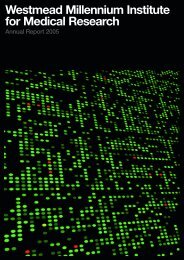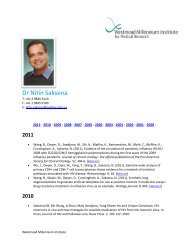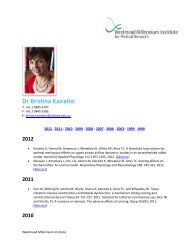Translating >> - Westmead Millennium Institute
Translating >> - Westmead Millennium Institute
Translating >> - Westmead Millennium Institute
Create successful ePaper yourself
Turn your PDF publications into a flip-book with our unique Google optimized e-Paper software.
44 45 > Research Report // AR 2006<br />
Dysregulation of normal muscle function and its<br />
contribution to the development of fatty liver disease.<br />
The liver plays a central role in processing macronutrients<br />
in response to the influx of nutrients and hormones such<br />
as insulin. While the liver maintains fasting blood glucose<br />
concentrations, skeletal muscle and fat tissue are the major<br />
sites of insulin stimulated glucose disposal. Furthermore,<br />
muscle is intricately involved in whole body lipid (fat)<br />
homeostasis. In these additional studies, we examined<br />
changes in the expression of key genes regulating energy<br />
uncoupling, lipid oxidation and glucose transport in the<br />
muscle and liver of mice that develop NASH when fed a<br />
diet deficient in the compounds methionine and choline<br />
(MCD). Our results indicated that lipid oxidation in muscle<br />
is reduced during MCD feeding, thereby delivering a higher<br />
lipid load to the liver and contributing to the development<br />
of hepatic steatosis. Thus, there appears to be a complex and<br />
intricate link between the liver and muscle with regard to<br />
lipid homeostasis that may in part explain lipid accumulation<br />
in the livers of persons who develop fatty liver disease.<br />
The role of the hormone adiponectin and its receptors in<br />
hepatic fibrosis<br />
Liver injury from any cause can lead to hepatic fibrosis, a<br />
process which is mediated by the hepatic stellate cell (HSC).<br />
Adiponectin, a recently characterised hormone secreted<br />
by fat cells with anti-inflammatory and anti-atherogenic<br />
properties may serve as a novel protein in the modulation<br />
of liver fibrosis. Researchers at the Storr Liver unit became<br />
interested in this protein when we noted that low levels<br />
of adiponectin were associated with the development of<br />
NASH in humans. In contrast, high levels of this hormone<br />
appear to be protective for the development of a fatty<br />
liver. We therefore sought to characterise the modulation<br />
of adiponectin receptors which mediate the function of<br />
adiponectin during the activation of HSCs to a profibrogenic<br />
cell type. While this project is in its infancy, we have<br />
demonstrated significant decreases in the expression levels<br />
of the AdipoR1 but not the AdipoR2 receptor during the<br />
activation of HSCs. In contrast, when HSCs were treated<br />
with the cytokine transforming growth factor beta, the<br />
expression of AdipoR2 was up-regulated. Our results indicate<br />
that differential modulation of adiponectin receptors occurs<br />
in vitro during HSC culture and in response to profibrogenic<br />
cytokines. These changes in receptor expression may play<br />
an important role in modulating the fibrogenic response<br />
of the liver to chronic injury. Further studies are therefore<br />
underway to determine the molecular basis of these effects<br />
and to determine if modulation of these receptors in the liver<br />
can lead to reductions in hepatic fibrosis in patients with fatty<br />
liver disease.<br />
Molecular pharmacology research<br />
The Molecular Pharmacology group, lead by Professor Chris<br />
Liddle is engaged in research into the mechanisms regulating<br />
the metabolism and transport of both xenobiotic compounds<br />
(such as therapeutic drugs) and endobiotics (such as lipids,<br />
cholesterol and bile acids) within the liver. Nuclear receptors<br />
are key intracellular proteins that “sense” the presence of<br />
these molecules and they have been working to exploit these<br />
receptors as targets to develop new treatments for a range<br />
of liver diseases. Parts of this work are being performed in<br />
collaboration with the laboratory of Professor Ron Evans at<br />
the Salk <strong>Institute</strong>, La Jolla, California. In collaboration with<br />
the Cancer Pharmacology Unit at Concord Hospital we<br />
have been investigating the altered metabolism of drugs that<br />
frequently occurs in patients with advanced cancer with a<br />
view to developing interventions that will allow such patients<br />
to be able to receive the benefit of full doses of vital cancer<br />
chemotherapy. Our recent work in the field of regulatory<br />
mechanisms in drug metabolism has led to the generation<br />
of two patents, which have been successfully licensed to the<br />
pharmaceutical industry. Royalties arising from these patents<br />
now provide significant ongoing funding for research projects<br />
with the Storr Liver Unit.<br />
Neuroscience and Vision<br />
Brain Dynamics Centre<br />
Brain connectivity projects<br />
These projects are focused on understanding the mechanisms<br />
of how the brain binds information into a coherent whole,<br />
and determines what is significant and important, and what<br />
is not. Understanding the mechanisms of integrative brain<br />
function is important for identifying the causes of disorders<br />
of mental health.<br />
A second focus of these projects is on the role of age and<br />
sex differences. Major psychiatric disorders have striking<br />
differences in their prevalence in males versus females, and<br />
peak ages of onset, such that understanding these factors is<br />
important for understanding the processes of mental illness.<br />
A PhD thesis on this topic will be completed this year.<br />
Towards a continuum of orienting and defensive responses<br />
This ARC Discovery project is focused on identifying the<br />
neural mechanisms underlying how we determine what is<br />
significant in the environment, and process it accordingly.<br />
The ability to discriminate what is significant and important<br />
from what is not is crucial to effective information processing.<br />
Thus, a breakdown in the mechanism of significance<br />
processing may underlie major psychiatric disorders.<br />
PhD research in this area was awarded the Tasman-Lovell<br />
medal this year for the best project.<br />
Development of integrative markers of brain function<br />
This is another ARC linkage project and is focused on<br />
integrating genetic information with cognitive, emotional<br />
and neuroimaging measures to identify evidence-based<br />
biological markers of complex brain function. Biological<br />
markers are important tools for identifying predisposing<br />
factors to disease, diagnosis, treatment evaluation, and the<br />
monitoring of disease progression.<br />
Emotion processing in adolescence and application to<br />
conduct disorder<br />
This project is focused on understanding the biological<br />
basis of emotion processing in adolescence, which is a peak<br />
period for the onset of emotional and behavioural disorders.<br />
These results will provide a platform for identifying specific<br />
disturbances in emotion-related brain function in children<br />
and adolescents with conduct disorder.<br />
Results to date show a striking change in brain function<br />
profile for salient emotions of fear and happiness from<br />
childhood (6-7 years) to adolescence (8-13) years to later<br />
teenage years (14-15 years), when the profile becomes more<br />
like that of an adult<br />
Identifying the ‘signature’ for ADHD and<br />
treatment predictions<br />
This project has used tests of emotion cognition and brain<br />
function to identify objective markers of ADHD and<br />
response to stimulants in ADHD. These markers were found<br />
to classify over 80% of ADHD adolescents.<br />
Posttraumatic stress disorder (PTSD) biological markers<br />
and treatment response<br />
This project aims to develop the most effective treatments for<br />
acute and chronic PTSD. Cognitive behavioural treatments<br />
(CBT) are the current first line treatment of PTSD, but<br />
response can be heterogeneous. This project aims to identify<br />
the most effective elements of CBT treatment of PTSD.<br />
The group conducted a randomized controlled trial on<br />
103 participants with PTSD to examine the most effective<br />
combination of treatment elements for PTSD. Specifically,<br />
the group examined whether cognitive therapy (CT)<br />
enhanced treatment response to exposure-based therapies<br />
(prolonged (PE) and invivo (IV) in an 8-week CBT program<br />
conducted in the Clinic for Traumatic Stress at BDC.<br />
Acute stress disorder treatment efficacy<br />
This study examined the relative efficacy of cognitive therapy<br />
(CT) and exposure treatments in acute trauma populations<br />
(within 3-4 weeks of trauma) in a randomized controlled<br />
trial. Results indicate that early intervention following trauma










